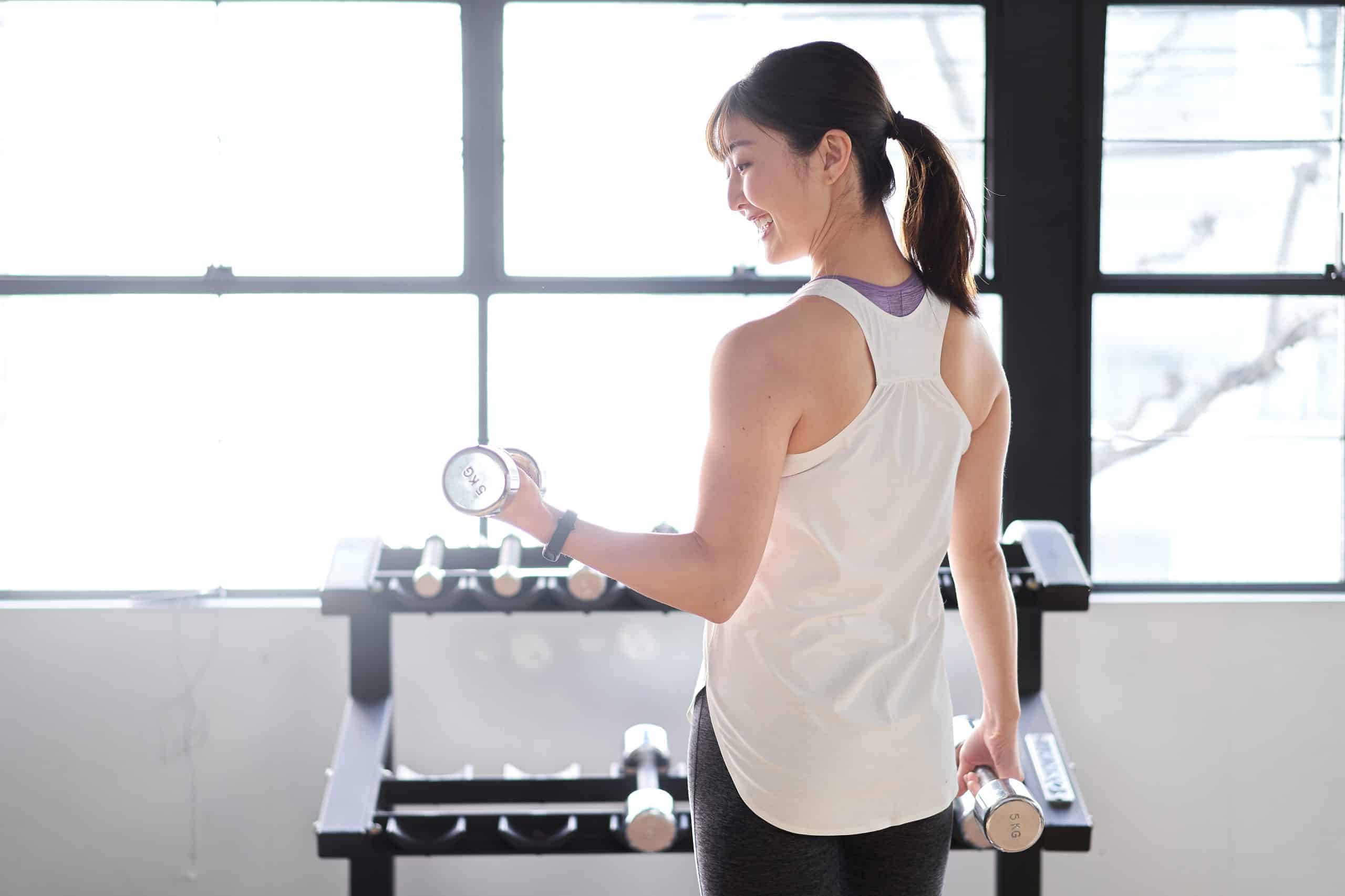Whether your goal for working out is to build muscle, improve posture, or reduce pain, these 10 trapezius exercises will help get you there. The trapezius is a large, triangular-shaped muscle that covers the upper back and extends down to the middle of the spine. It’s responsible for moving the shoulders and supporting the neck. While the trapezius muscle is not typically a problem area for most people, it can become weak or tight from poor posture or repetitive motions. This can lead to pain in the neck, shoulders, and upper back. Strengthening the trapezius muscle can help alleviate these symptoms and improve your overall strength and posture. Read on to understand the anatomy of the trapezius muscle and the best trapezius strength exercises.
Get your personalized
meal plan!
Anatomy Of The Trapezius Muscle
The trapezius muscle is a large, triangular-shaped muscle that spans from the back of your skull, down your spine, and all the way out to your shoulder blades. It is responsible for both moving your shoulders and stabilizing them.
The trapezius muscle is divided into three parts, each with different origins, insertions, and functions:
- Upper trapezius: The upper trapezius muscle originates from the base of your skull, and inserts into your shoulder blade. It is responsible for elevating your shoulders.
- Middle trapezius: The middle trapezius muscle originates from the spinous processes of your vertebrae, and inserts into your shoulder blade. It is responsible for retracting your shoulder blades.
- Lower trapezius: The lower trapezius muscle originates from the spinous processes of your vertebrae, and inserts into your shoulder blade. It is responsible for depressing your shoulders.
The trapezius muscle is innervated by the accessory nerve (CN XI). This nerve arises from the spinal cord and innervates all of the muscles of the neck and shoulder (4).
The trapezius muscle is a key player in everyday movements, such as shrugging your shoulders, reaching up to scratch your head, or combing your hair. It is also very important in stabilizing your shoulder girdle when you lift heavy objects.
Read More: Increase Shoulder Mobility: Why And How To Do It
Why Strengthen The Trapezius Muscle?
There are many reasons why you might want to strengthen your trapezius muscle, including:
Better Posture
For one, having a strong upper back can help improve your posture. Slouching and rounding your shoulders is a common problem, especially if you sit at a desk all day. This can lead to tightness in your chest and weakness in your upper back.
By strengthening your trapezius muscle, you can help pull your shoulders back and stand up straighter. This will not only improve your posture but can also help relieve pain in your neck and shoulders (3).
Injury Prevention
Another reason to strengthen your trapezius is to prevent injuries. This muscle helps stabilize the shoulder, so it’s important for overhead movements like throwing a ball or reaching for something on a high shelf.
If the muscle is weak, it can’t do its job properly and you may be more likely to injure your shoulder. Strengthening the muscle can help prevent these types of injuries (1).
Better Performance
Strengthening your trapezius can also improve your performance in activities that require a strong upper back. This includes sports like tennis, swimming, and rowing. It can also help with weightlifting and other strength-training exercises.
If you have weak trapezius muscles, you may not be able to lift as much weight or perform the exercises with proper form. This means you won’t be recruiting all the muscles in your back and won’t get as much out of the workout.
Aesthetics
Who doesn’t want a strong, sculpted back? The trapezius muscle is one of the key muscles in giving you that V-shaped torso.
While you can’t spot-reduce fat, building muscle in this area can help create the appearance of a narrower waist and a broader back. This can give you a more defined and muscular look.
Looking for a way to break the vicious cycle of weight loss and tone up all the jiggly parts? Watch the extra pounds fly off and your muscles firm up with the BetterMe app!
10 Trapezius Muscle Strength Exercises
Now that you know the benefits of strengthening your trapezius muscle, it’s time to get to work.
Here are 10 exercises that will help you build strength in this area:
1. Barbell Shrug
The barbell shrug is a basic exercise that recruits the trapezius muscle.
- Start by standing with your feet shoulder-width apart and a barbell in front of you.
- Grip the barbell with your hands shoulder-width apart and let it hang at arm’s length in front of you.
- Keeping your back straight, shoulders down, and core engaged, raise your shoulders as high as you can.
- Pause for a count of two, then slowly lower them back down to the starting position.
- Do 10 to 12 reps.
2. Dumbbell Shrug
The dumbbell shrug is similar to the barbell shrug, but using dumbbells instead of a barbell allows for unilateral (single-sided) work. This can help correct any imbalances you may have between your left and right sides.
- Start by standing with your feet shoulder-width apart and a dumbbell in each hand.
- Let the dumbbells hang at arm’s length by your sides, with your palms facing your thighs.
- Keeping your back straight, shoulders down, and core engaged, raise your right shoulder as high as you can.
- Pause for a count of two, then slowly lower it back down to the starting position.
- Repeat with your left shoulder. That’s one rep.
- Do 10 to 12 reps.
3. Kirk Shrug
The kirk shrug is a variation of the barbell shrug that requires a thumbless grip. This can help increase your grip strength and recruitment of the lower trapezius muscle. Consequently, it improves posture and performance in lifts that require a firm grip, such as the deadlift.
- Start by standing with your feet shoulder-width apart and a barbell in front of you.
- Grip the barbell with your hands shoulder-width apart using a thumbless (overhand) grip.
- Keeping your back straight, shoulders down, and core engaged, raise your shoulders as high as you can.
- Pause for a count of two, then slowly lower them back down to the starting position.
- Do 10 to 12 reps.
4. EZ Bar Upright Row
An EZ bar is a type of barbell with an angled grip that allows for more wrist and forearm comfort than a traditional barbell. The upright row is an exercise that targets the trapezius as well as the muscles in the front of the shoulder (the anterior deltoid).
- Start by standing with your feet shoulder-width apart and an EZ bar in front of you.
- Grip the bar with your hands shoulder-width apart using an overhand grip.
- Keeping your back straight and core engaged, raise the barbell to just below chin level, leading with your elbows.
- Pause for a count of two, then slowly lower it back down to the starting position.
- Do 10 to 12 reps.
Read More: What Do Lateral Raises Work? How This Exercise Can Benefit Your Workout Routine
5. Dumbbell Lateral Raise
The lateral raise is a well-known shoulder exercise that primarily targets the middle deltoid muscle. However, it also recruits the trapezius muscle to a lesser extent.
- Start by standing with your feet shoulder-width apart and a dumbbell in each hand.
- Let the dumbbells hang at arm’s length by your sides, with your palms facing your thighs.
- Keeping your back straight and core engaged, raise your arms out to the sides until they’re parallel with the ground.
- Pause for a count of two, then slowly lower them back down to the starting position.
- Do 10 to 12 reps.
6. Barbell Overhead Press
The overhead press is a compound exercise that targets the trapezius muscle as well as the muscles in the front of the shoulder (the anterior deltoid) and the side of the shoulder (the lateral deltoid).
- Start by standing with your feet shoulder-width apart and a barbell in front of you.
- Grip the barbell with your hands shoulder-width apart using an overhand grip.
- Keeping your core engaged, raise the barbell overhead until your arms are straight.
- Pause for a count of two, then slowly lower it back down to the starting position.
- Do 10 to 12 reps.
7. Farmers Carry
This loaded carry exercise not only works your grip and forearm muscles but also activates your whole body, including your trapezius muscle.
- Start by standing with your feet shoulder-width apart and a weight in each hand.
- Let the weights hang at arm’s length by your sides, with your palms facing your thighs.
- Keeping your shoulders down and your core engaged, walk forward for a specific distance or time.
- To make the exercise more challenging, you can increase the weight of the dumbbells or the length of time that you carry them.
8. One-Arm Dumbbell Row
The one-arm dumbbell row is a classic back exercise that targets the muscles along the side of the back, including the trapezius. It has the unique benefit of being able to isolate each side of the back, which can help correct any imbalances.
- Start by positioning a dumbbell on the ground next to your right foot.
- Bend your knees and hinge forward at the hips until your back is nearly parallel to the ground.
- Place your right hand on the dumbbell and let your left arm hang down. This is the starting position.
- Keeping your core engaged, lift the dumbbell to the side of your chest, leading with your elbow.
- Pause for a count of two, then slowly lower it back down to the starting position.
- Do 10 to 12 reps, then repeat on the other side.
9. Kettlebell Swings
The kettlebell swings primarily work the muscles in the posterior chain, including the trapezius muscle. They’re a great exercise for improving power and explosive ability.
- Start by standing with your feet shoulder-width apart and a kettlebell in front of you.
- Bend your knees slightly and hinge forward at the hips until your back is nearly parallel to the ground.
- Grab the kettlebell with both hands and let it hang between your legs. This is the starting position.
- Keeping your core engaged, swing the kettlebell up to shoulder height. As you swing the kettlebell up, squeeze your glutes and thrust your hips forward.
- Allow the momentum from the swing to carry the kettlebell back down between your legs, then repeat.
- Do 10 to 12 reps.
10. Deadlift
The deadlift is a compound exercise that works the muscles along the back of the body, including the trapezius muscle. It also targets the muscles in the front of the leg (quadriceps) and the back of the leg (hamstrings).
- Start by standing with your feet hip-width apart and a barbell in front of you.
- Bend your knees and hinge forward at the hips until your back is nearly parallel to the ground.
- Grab the barbell with an overhand grip, hands shoulder-width apart.
- Keeping your core engaged, lift the barbell up, leading with your hips until you’re standing upright.
- Pause for a count of two, then slowly lower it back down to the starting position.
- Do 10 to 12 reps.
If you tend to let yourself off the hook, raise the white flag when things get tougher than you expected, send yourself on an unconscious binge-eating trip – BetterMe app is here to help you leave all of these sabotaging habits in the past!
How To Safely Perform Strength Exercises For Trapezius?
Now that you know some of the best exercises to target your trapezius muscle, it’s important to learn how to perform them safely and effectively. Here are a few pointers:
- Do a warm-up first. Before you start your strength-training workout, be sure to warm up with some light cardio and dynamic stretches. This will help increase blood flow to your muscles and reduce your risk of injury (5).
- Think of proper form vs. ego lifting. When you’re lifting weights, it’s important to focus on proper form rather than how much weight you’re lifting. Lifting with good form will help you target the right muscles and avoid injury. Ego lifting (lifting more weight than you can safely handle) puts you at a higher risk for injury.
- Structure your workout. When you’re designing your strength-training workout, be sure to include a mix of exercises that target all the major muscle groups. For trapezius-specific activities, aim for 2 to 3 sets of 10 to 12 reps.
- Give your muscles time to rest and recover: After a strenuous workout, your muscles need time to repair and rebuild. That’s why it’s important to give yourself at least one day of rest between strength-training workouts (2).
If you have any questions or concerns about performing these exercises safely, be sure to consult with a certified personal trainer or other fitness professional. Remember, there’s no “quick fix” when it comes to building strength. It takes time, patience, and consistent effort. But if you stick with it, you’ll see results!
The Bottom Line
These are just a few examples of exercises that can help strengthen the trapezius muscle— which is a muscle responsible for both moving your shoulders and stabilizing them. As with any muscle group, be sure to warm up before you start and to listen to your body if you feel any pain or discomfort.
DISCLAIMER:
This article is intended for general informational purposes only and does not serve to address individual circumstances. It is not a substitute for professional advice or help and should not be relied on for making any kind of decision-making. Any action taken as a direct or indirect result of the information in this article is entirely at your own risk and is your sole responsibility.
BetterMe, its content staff, and its medical advisors accept no responsibility for inaccuracies, errors, misstatements, inconsistencies, or omissions and specifically disclaim any liability, loss or risk, personal, professional or otherwise, which may be incurred as a consequence, directly or indirectly, of the use and/or application of any content.
You should always seek the advice of your physician or other qualified health provider with any questions you may have regarding a medical condition or your specific situation. Never disregard professional medical advice or delay seeking it because of BetterMe content. If you suspect or think you may have a medical emergency, call your doctor.
SOURCES:
- Core Stability Training for Injury Prevention (2013, nih.gov)
- Effects of Consecutive Versus Non-consecutive Days of Resistance Training on Strength, Body Composition, and Red Blood Cells (2018, nih.gov)
- Improve Your Posture for Better Health (2017, nih.gov)
- Neuroanatomy, Cranial Nerve 11 (Accessory) (2022, nih.gov)
- Why Warming Up and Cooling Down is Important (n.d., tricitymed.org)












